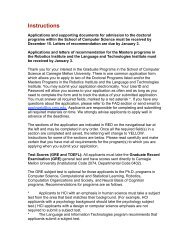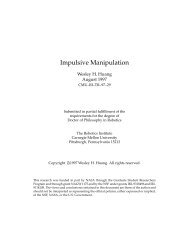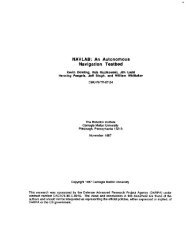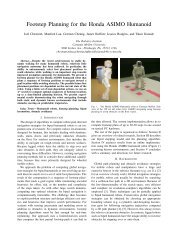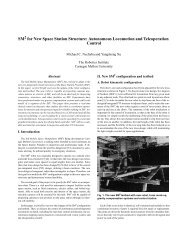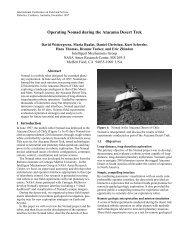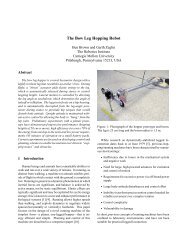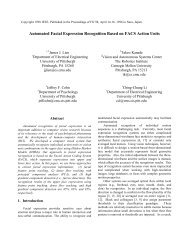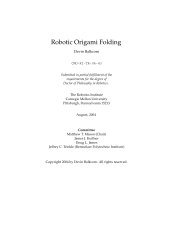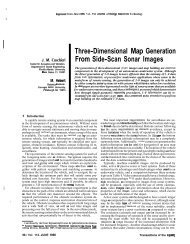A System for Automated Fixture Planning with Modular Fixtures
A System for Automated Fixture Planning with Modular Fixtures
A System for Automated Fixture Planning with Modular Fixtures
You also want an ePaper? Increase the reach of your titles
YUMPU automatically turns print PDFs into web optimized ePapers that Google loves.
Vise jaws should be pked against the part. face to k e. Once both jaws are placed against the part, the<br />
contactareabe~eachjswandthepertcanbeidentifiedarabolwiingconvexpolygon. Each vertexof<br />
a polygon can be represented by a m h . Since both polygons lie on parallel planes, all wrenches<br />
describing each polygon are perpendicular to the planes. Screw theory can be used to detect any part<br />
mouon dunng clamping.<br />
Geomemc reasoning can be used to determine if the pan would rotate due to the locarion of a movable<br />
jaw. The part will move during contact by a movable jaw if two polygons are not overlapped at all when<br />
they are projected onto a plane paIlel to both.<br />
3.4. Computation of clamping <strong>for</strong>ce<br />
This section desuibes a method to estimate necessary clamping <strong>for</strong>ce wben a fixture plan is generated<br />
<strong>with</strong> overhead clamps 01 a vise. Estimation of clamping <strong>for</strong>ce is the most critical process because it affects<br />
the quality of a fatme plan. ‘Ihe inadequate clamping <strong>for</strong>ce will scrap the part by not holding the pan<br />
rigidly during machining. Applying a larger clamping <strong>for</strong>ce thau necessary may deflect or de<strong>for</strong>m the part.<br />
nus, it is necessray to estimate the minimum clamping <strong>for</strong>ce, In order to estimate necessary clamping<br />
<strong>for</strong>ce, cutfing <strong>for</strong>ce should first be. estimated accurately. However. the accurate estimation of cutting <strong>for</strong>ce<br />
is difficult becaw. it depends on cutting pammtm such as the depth of cut aod feed rate, etc, as well as<br />
tool weas which is hard to quanm. Experienced tool designers can make a reasonable estimation of the<br />
magnitude. of cutting <strong>for</strong>ce.<br />
As discussed earlier, in fixture plans <strong>with</strong> ovemead clamps 01 a vise, planar motions such as translation<br />
on a plane and mtation a ht a0 axis peqendicular to the plane need to be restraiOed by friction <strong>for</strong>ce.<br />
Since the friction d cimt between the pft and fwure mmponents is typically small, a large damping<br />
<strong>for</strong>ce is required to mainrain a pan’s W e and moment equilibrium during machining, when the. motion<br />
due to the cutting <strong>for</strong>ce must be mixed mainly by friction <strong>for</strong>ce.<br />
When a cutting <strong>for</strong>ce is directed out of the plane, the. necessafy clamping <strong>for</strong>ce is much smaller since the<br />
part’s equilibrium does not depend on fricth <strong>for</strong>ce. Once the magnitude and direction of the cutting <strong>for</strong>ce<br />
are e s t i d the clamping <strong>for</strong>ce’s magnitude can be estimated <strong>with</strong> <strong>for</strong>mulas found in a machining<br />
hdbmk.<br />
3.4.1. Estimation of Cutting Force<br />
Since the magnitude of the clamping <strong>for</strong>ce is directly affected by the magnitude and direction of cutting<br />
<strong>for</strong>ce. it is impatant to estimate the magoin& and direction of every cutting <strong>for</strong>ce applied to the pat as<br />
precisely as possible.<br />
Here, only the esrimatiCm of the magnitude and the direction of drilling and milling operations are<br />
considered In a drilling operation. the direction of thrust is equal to the direction of drill feed. Reasonable<br />
estimates of torque and thrust of sharp twist drills of various sizes and &signs uio be made from the<br />
following <strong>for</strong>mulas [Handbook 881:




